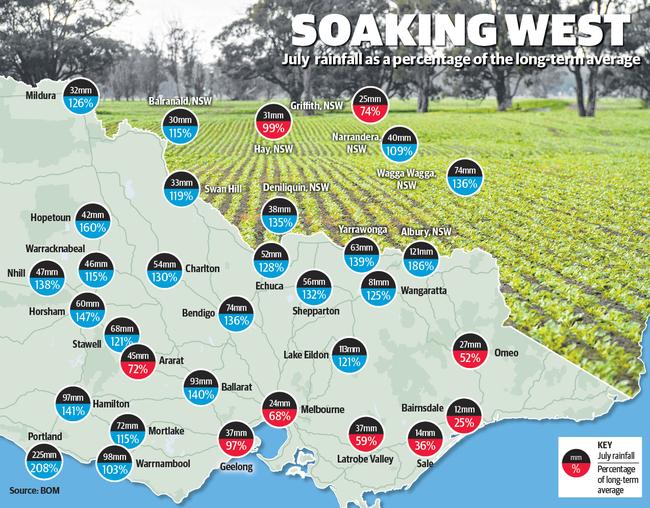Weather southeast Australia: Where the rain fell in July
Compare July falls across Victoria on our map and see how soil moisture will impact the coming season.

Gippsland was drier than normal in the midwinter month, while the Western District had a soaking.
In what is almost a reversal of what happened at the start of winter, Bureau of Meteorology figures show Gippsland received below average rain with a large portion of the area recording the lowest 10 per cent of July totals, while most of southern NSW and the rest of Victoria received above average falls.
Three sites in the south west — Coleraine (41mm), Portland (38.6mm) and Cape Nelson Lighthouse (39.2mm) — had their highest July daily rainfall on record.
Analysis of the 33 weather stations monitored by The Weekly Times, show all but nine recorded a wetter-than-average July.
Portland lead the way, recording 225mm or 208 per cent of its long-term average. It also broke its record for the highest July total rainfall, which was previously 219mm set in 2013.
Other centres to receive a decent soaking included Albury, NSW, (121mm or 186 per cent of its normal total), Hopetoun (42mm or 160 per cent), Horsham (60mm or 147 per cent), Nhill (47mm or 138 per cent), Hamilton (97mm or 141 per cent), Ballarat (93mm or 140 per cent), Yarrawonga (63mm or 139 per cent) and Wagga Wagga, NSW, (74mm or 136 per cent).
At the other end of the scale, Bairnsdale’s 12mm was 25 per cent of its long-term average, Sale’s 14mm equated to 36 per cent, Omeo’s 27mm equalled 52 per cent and Griffith, NSW, recorded 25mm or 74 per cent.
According to BOM, across Victoria rainfall was 2 per cent above the average of 71mm for July, the highest July rainfall since 2016. And it brings the year-to-date total rain to 7 per cent above average.
There was widespread rain across Victoria in the past week, with some of the best falls in the North East, southwest and southern Wimmera. Mount William recorded 36mm, Edenhope 28mm, Daylesford 36mm, Casterton 45mm and Portland 40mm.
Across NSW in the past week, the Northern Tablelands and southwest areas fared the best from small falls, with Armidale receiving 21mm for the week, Tooma 25mm and Tumbarumba 16mm.
SOIL MOISTURE PROBES HELPING GRAIN GROWERS
Grain growers know it is soil moisture that can make or break a crop.
If growers are heading into August will little moisture stored in the soil, their fortunes are heavily dependent on rainfall right through to grain fill.
Agriculture Victoria’s soil moisture monitoring project with 15 permanent probes installed across the state is showing the northern and southern Mallee largely with low soil moisture, while the Wimmera is in a good position and the northeast and southern regions saturated.
Agriculture Victoria seasonal risk agronomist Dale Boyd said farmers would be considering soil moisture levels in conjunction with crop development stage, the rain outlook and commodity prices to assess their management options.
Mr Boyd said some farmers were now investing in permanent soil moisture probes on their properties to help their decision making.
“I would hate to be trying to guess soil moisture without a probe,” he said.
“It makes decisions more informed.
“Right now, farmers are making substantial input decisions, particularly on nitrogen fertilisers.”
Mr Boyd said August was a “really critical month” for soil moisture levels and rainfall.
“It can really set the season up,” he said.
“Farmers don’t want water stress at flowering and grain fill”.
Agriculture Victoria’s probes at Ouyen, Birchip and Brim show moisture levels in the 30cm to 100cm soil profile to be low.
The Werrimull site in the far northwest of the state was much wetter but Mr Boyd said it was an anomaly.
He said the probe was in an paddock which got hit with an isolated 50mm thunderstorm on January 1, plus last year’s crop was cut for hay.
He said any paddocks cut for hay generally had higher soil moisture levels the following year.
“Mallee moisture levels are low but at least it is being detected,” he said.
Moisture probes at Taylor’s Lake west of Horsham were showing moderate levels of stored water while at Sheep Hills, north of Minyip, water levels were much higher.
Probes at Youanmite, Raywood, Serpentine, Lake Bolac, Hamilton and Giffard West in Gippsland were showing soils were saturated.
– Peter Hemphill
MORE



